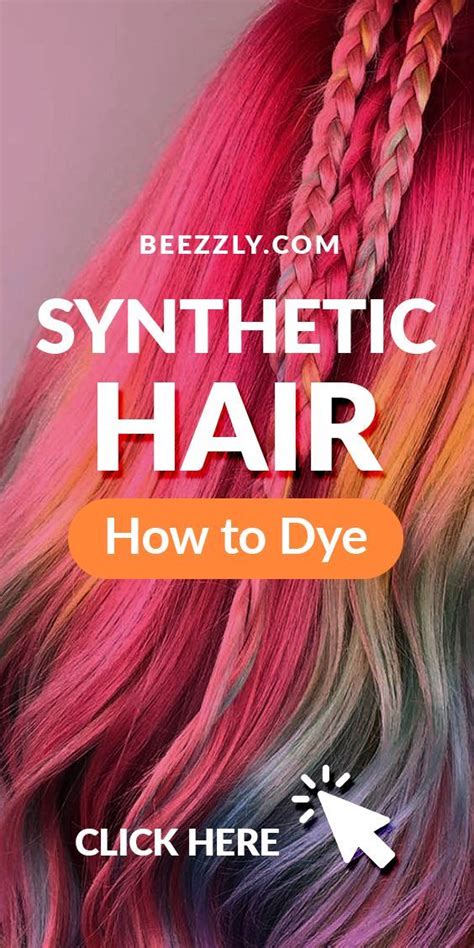Introduction
Synthetic hair dyes have revolutionized the hair coloring industry, providing vibrant and diverse color options for all hair types. Unlike natural dyes, which rely on plant pigments, synthetic dyes are chemically engineered to create a wide range of colors, from subtle highlights to bold, statement-making shades.

Types of Synthetic Hair Dyes
Synthetic hair dyes fall into two main categories:
1. Permanent Hair Dyes
- Penetrate the hair shaft and alter its natural pigment.
- Last for several weeks to months, depending on the type of dye and frequency of washing.
- Examples: Ammonia-based dyes, peroxide-based dyes
2. Semi-Permanent Hair Dyes
- Deposit color on the hair’s surface without altering its natural pigment.
- Fade gradually after 4-8 washes.
- Examples: Demi-permanent dyes, glosses, toners
Benefits of Synthetic Hair Dye
Synthetic hair dyes offer a multitude of benefits:
- Wide Color Range: Choose from over 120 shades, from natural to vivid fantasy colors.
- Long-Lasting Color: Permanent dyes provide lasting color, eliminating frequent touch-ups.
- Customizable: Mix and match different colors to create personalized shades.
- Versatile: Can be used on all hair types, including textured and chemically treated hair.
- Professional Results: Salon-quality color achievable at home.
How Synthetic Hair Dye Works
Synthetic hair dyes contain three main components:
- Base: The color pigment that attaches to the hair.
- Developer: A chemical solution that lifts the hair’s cuticle, allowing the base to penetrate.
- Conditioners: To protect and hydrate the hair during and after the coloring process.
Selecting the Right Synthetic Hair Dye
Choosing the right synthetic hair dye depends on:
- Desired Color: Determine the specific shade you want to achieve.
- Hair Type: Consider your hair’s texture, porosity, and current color.
- Skill Level: Permanent dyes may require professional assistance.
Step-by-Step Guide to Applying Synthetic Hair Dye
1. Preparation:
- Read the instructions carefully.
- Wear gloves and an old shirt.
- Section your hair.
2. Mixing the Dye:
- Combine the base and developer according to the manufacturer’s instructions.
3. Application:
- Apply the dye evenly to each section of hair.
- Use a brush or comb to distribute the dye thoroughly.
- Cover the hair with a shower cap.
4. Processing Time:
- Leave the dye on for the specified processing time.
- Check the hair regularly to avoid over-processing.
5. Rinsing and Conditioning:
- Rinse the hair thoroughly with warm water.
- Apply a deep conditioner to hydrate the hair.
Tips and Tricks
- Avoid Over-Processing: Leave the dye on for the minimum amount of time necessary to achieve your desired color.
- Use a Deep Conditioner: Protect your hair from damage by regularly using a deep conditioner.
- Toning with Semi-Permanent Dye: Add depth and richness to your color by applying a semi-permanent dye in a complementary shade.
- Retouch Roots Regularly: Maintain your color by touching up roots as they grow out.
Why Synthetic Hair Dye Matters
Synthetic hair dyes empower individuals to express their creativity and individuality through their hair. They enhance confidence, provide a sense of renewal, and allow for endless color transformations.
Future Applications of Synthetic Hair Dye
New technologies are emerging to create even more versatile and innovative synthetic hair dyes. Key future applications include:
- Biodegradable Dyes: Dyes that break down naturally, reducing environmental impact.
- Smart Dyes: Dyes that change color based on temperature, light, or other environmental factors.
- Hair-specific Colorants: Dyes designed specifically for different hair types and textures, providing optimal results.
Conclusion
Synthetic hair dyes continue to revolutionize the hair coloring industry, offering a wide range of vibrant and long-lasting color options. By understanding the different types, benefits, application techniques, and future applications, individuals can confidently achieve their desired hair color and embrace the transformative power of synthetic hair dyes.
- Synthetic hair dyes
- Hair color
- Permanent dyes
- Semi-permanent dyes
- Color customization
- Hair dyeing techniques
- Hair care
Table 1: Types of Synthetic Hair Dyes
| Type | Description | Duration |
|---|---|---|
| Permanent | Alters natural pigment | Several weeks to months |
| Semi-Permanent | Deposits color on hair’s surface | 4-8 washes |
Table 2: Benefits of Synthetic Hair Dye
| Benefit | Explanation |
|---|---|
| Wide Color Range | Over 120 shades available |
| Long-Lasting Color | Permanent dyes provide lasting results |
| Customizable | Mix and match shades for personalized color |
| Versatile | Suitable for all hair types |
| Professional Results | Salon-quality color achievable at home |
Table 3: Step-by-Step Guide to Applying Synthetic Hair Dye
| Step | Action |
|---|---|
| Preparation | Gather materials, section hair |
| Mixing the Dye | Combine base and developer |
| Application | Apply dye evenly, cover hair |
| Processing Time | Leave dye on for specified time |
| Rinsing and Conditioning | Rinse hair, apply deep conditioner |
Table 4: Tips and Tricks for Synthetic Hair Dye
| Tip | Benefit |
|---|---|
| Avoid Over-Processing | Preserves hair health |
| Use a Deep Conditioner | Hydrates and protects hair |
| Toning with Semi-Permanent Dye | Adds depth and richness |
| Retouch Roots Regularly | Maintains color intensity |
